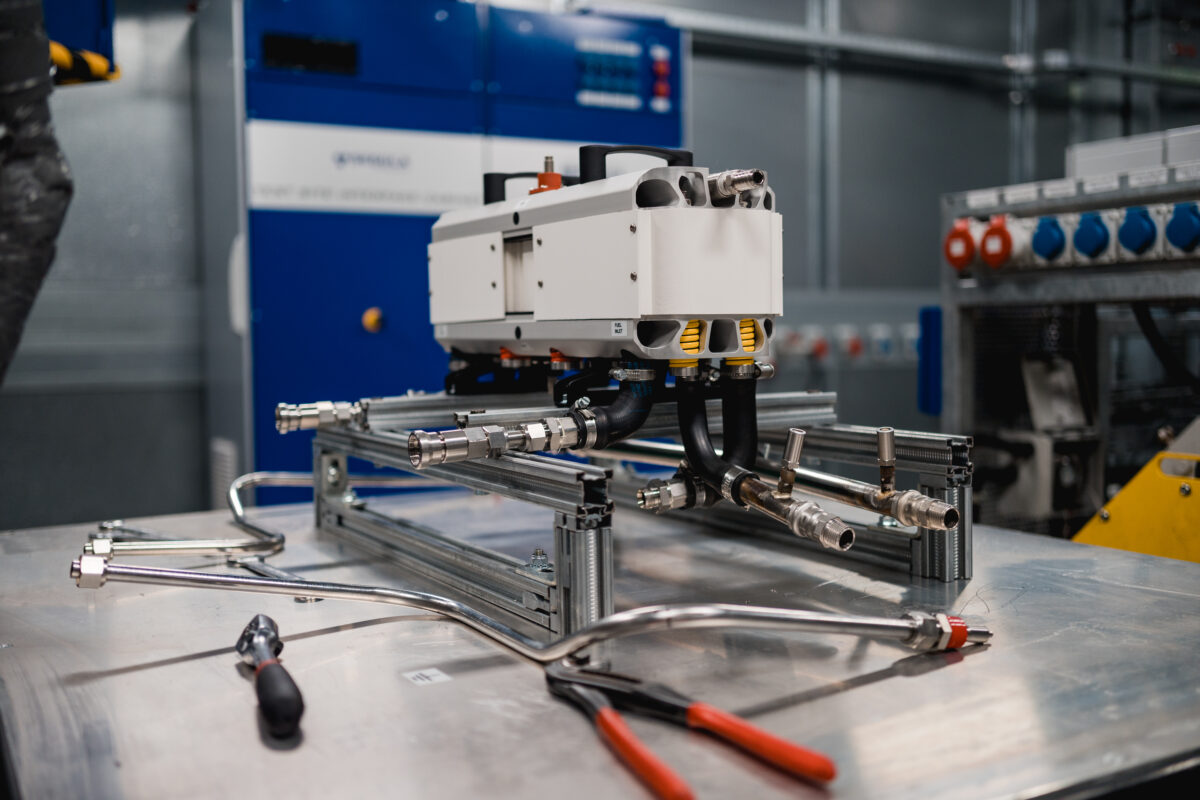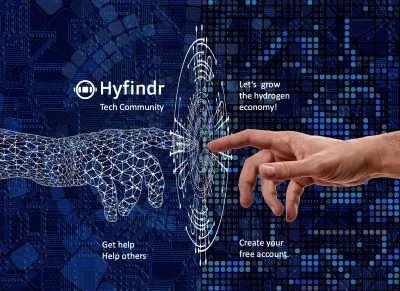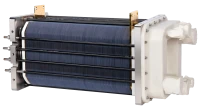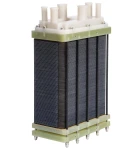Browse fuel cell systems from leading suppliers on our marketplace!
What is a hydrogen fuel cell?
In hydrogen-powered fuel cells a reaction of hydrogen gas with oxygen from the ambient air generates electricity.
Hydrogen fuel cell technology is today at the forefront of fuel cell development. Fuel cells powered by hydrogen are today the most prominently used fuel cell type. Hydrogen is the most simple fuel to use. In its liquefied state, hydrogen has a high energy density. Hydrogen burns clean into water vapor, thus offering the opportunity to become completely detached from a carbon-based energy generation cycle.
As such, hydrogen fuel cells offer several benefits that make them an important part of the transition to a more sustainable energy system.
- Firstly, a hydrogen fuel cell provides a clean and efficient source of energy. Hydrogen fuel cells produce electricity through a chemical reaction between hydrogen and oxygen, with the only byproduct being water. This makes them a low-carbon and environmentally friendly alternative to traditional fossil fuel power sources.
- Secondly, hydrogen fuel cells are highly versatile and can be used in a wide range of applications. They can be used to power vehicles, as well as to provide electricity for homes, businesses, and other types of infrastructure. This makes them a potentially important part of the transition to a more sustainable energy system.
How does a hydrogen fuel cell work?
A fuel cell produces electricity and process heat from the fuel supplied to it. A hydrogen fuel cell in its most elementary form consists of two electrodes: a negative electrode (or anode) and a positive electrode (or cathode). These two electrodes are surrounded by an electrolyte. Hydrogen fuel is supplied to the anode, and air (the “oxidant”) – containing oxygen – is fed to the cathode. In a hydrogen fuel cell, a catalyst at the anode separates hydrogen molecules into protons and electrons, which take different paths to the cathode. The electrons migrate through an external circuit, creating a flow of electricity. The protons migrate through the electrolyte to the cathode, where they combine with oxygen and the electrons to produce water and heat.
Hydrogen fuel cell technologies
Several different fuel cell technologies exist, and not all of them use hydrogen as a fuel. Some use other fuels, such as natural gas or methanol. However, due to its high energy density and clean burning properties, hydrogen is the most common fuel used in fuel cells today. Some examples of hydrogen fuel cell technologies are:
- Proton exchange membrane (PEM) fuel cells: Uses hydrogen
- Solid oxide fuel cells: Can use hydrogen, natural gas, or other fuels
- Phosphoric acid fuel cells: Uses hydrogen
- Alkaline fuel cells: Uses hydrogen or other fuels such as methanol or ethanol
- Molten carbonate fuel cells: Can use hydrogen, natural gas, or other fuels
- Direct methanol fuel cells: Uses methanol as fuel
- Regenerative fuel cells: Can use hydrogen, natural gas, or other fuels

Example: Hydrogen fuel cell testing and validation
Types of hydrogen fuel
There are also different types of hydrogen that can be used as a fuel.
- Compressed hydrogen gas
- Liquid hydrogen
- Hydride
The leading taxonomies for hydrogen include
- Renewable hydrogen, also known as “green hydrogen”, which is produced from renewable energy sources such as solar or wind power.
- Grey hydrogen, which is produced from fossil fuels such as natural gas.
- Blue hydrogen, which is produced from natural gas with carbon capture and storage (CCS) technology.
Hydrogen fuel cell systems
A hydrogen system refers to the infrastructure and equipment needed to produce, store, and distribute hydrogen gas. This may include hydrogen production facilities, pipelines, and storage tanks.
A hydrogen fuel cell system, on the other hand, refers to the equipment used to convert hydrogen into electricity. This may include fuel cells, inverters, and other electrical components.
Hydrogen fuel cells can be used in a variety of system setups to generate electricity and hydrogen. Here is a short overview of the different system setups:
| System Setup | Description |
| Electrolysis | Hydrogen is produced through the electrolysis of water, using electricity as an input. The resulting hydrogen can then be used as a fuel or stored for later use. |
| Fuel Cell | Hydrogen is reacted with oxygen in a fuel cell to produce electricity and water. |
| Hybrid | A combination of an electrolysis system and a fuel cell system, where excess electricity is used to produce hydrogen and the hydrogen is then used in the fuel cell to generate electricity when needed. |
Design principles for a hydrogen fuel cell system
To design and produce a highly efficient hydrogen fuel cell system that produces electricity, there are a few key design principles to consider:
- Use of high-quality materials: Fuel cells require high-quality materials in order to function effectively. This includes the use of materials that are resistant to corrosion and can withstand high temperatures.
- Control of operating conditions: Fuel cells operate best within a specific range of temperature and humidity. It is important to design the system to control these operating conditions to optimize performance.
- Efficient use of hydrogen: Fuel cells are most efficient when they operate at full load, so it is important to design the system to make use of all available hydrogen.
- Minimization of energy loss: Energy loss can occur due to factors such as heat transfer and electrical resistance. In order to maximize efficiency of hydrogen fuel cells it is important to design the system to minimize such losses.
Can hydrogen fuel cells be used bi-directionally?
It is possible to use a fuel cell stack for both hydrogen production and electricity generation. In essence, this is similar to using a motor in the inverse direction, as a generator. However, the fuel cell stack additionally includes the functionality of a battery or power buffer.
- Bi-directional use is typically achieved through the use of a hybrid system setup, which combines an electrolysis system with a fuel cell system.
- In a hybrid system, excess electricity is used to produce hydrogen fuel by way of the electrolysis of water, so the hydrogen can be used later in the fuel cell to generate electricity when needed.
There are several reasons why most fuel cell systems are currently only designed for one purpose, such as hydrogen production or electricity generation.
- One reason is that each application has specific requirements that must be met in order for the system to function effectively. For example, hydrogen production systems may require high levels of purity in the hydrogen gas produced, while electricity generation systems may require a high level of power output.
- Additionally, some hydrogen fuel cell technologies are better suited for one application over the other. For example, some fuel cell technologies are more efficient at producing hydrogen, while others are more efficient at generating electricity.
Overall, the choice of system setup (e.g., electrolysis, fuel cell, or hybrid) and the fuel cell technology employed will depend on the specific requirements of the application and the desired performance of the system.
Advantages and disadvantages hydrogen fuel cells
Advantage: High energy density improves productivity
Hydrogen fuel cells do not produce carbon dioxide emissions during operation. This applies even if the production of the hydrogen fuel cell, or of the hydrogen fuel, is today not yet accomplished in a carbon-free manner.
Specific to hydrogen mobility solutions, carbon-free operation means an advantage over combustion engine vehicles, which – apart from carbon dioxide emissions into the atmosphere – can emit small amounts of poisonous carbon monoxide.
The refueling process for hydrogen fuel cells is easy and takes about three minutes, a performance comparable to IC vehicles. Stationary applications could be supplied by a steady stream of hydrogen fuel from pipeline systems. Charging of batteries, by comparison, is today still a substantially longer and more complex process.
High energy density of hydrogen fuel in liquefied state offers an advantage over other types of fuels. Refueling intervals are therefore reduced for the same weight of fuel carried.
Advantage: Ability to eliminate the use of fossil fuels in the production of hydrogen fuel
It is possible and feasible to generate hydrogen using electrolysis, by extraction from water and separation from the oxygen molecule using an electrical current.
The electrical current used for this process can come from any source. A truly carbon-free way to use hydrogen fuel cell power is by using solar, wind, or other types of renewable energy to generate electricity for the process of hydrogen electrolysis.
Advantage: Green hydrogen can eliminate the need for centralized fuel storage and transportation
Hydrogen can be stored as either gas in high-pressure tanks or as a liquid in cryogenic temperatures. At first sight, all methods of hydrogen storage involve an inherent loss of energy. Compressing the hydrogen requires about 13% of the total energy content of the hydrogen itself, and if liquefied, these theoretical losses amount to approx. 40%.
However, if using green hydrogen, then production, storage, and dispensing of hydrogen fuel can be truly decentralized. Compared to fossil fuels, the need for industrial scale refineries, large storage facilities, and elaborate long-distance pipeline networks would no longer arise, because hydrogen fuel can be generated, stored in the interim, and dispensed soon after generation – all in one and the same place.
Safety in handling and sophisticated materials required – Disadvantage or advantage?
Hydrogen gas is highly flammable and can easily escape containment. If hydrogen gas escapes, it can corrode metals. This, in turn, can make these contaminated metals brittle and prone to breaking, posing a safety hazard in terms of metal fatigue.
However, this perceived disadvantage only gives further sustenance to the argument for a decentralized green hydrogen economy, which would eliminate the need for long-term storage and transportation of fuel over long distances. Because fossil fuels are likewise highly flammable – and most accidents involving this factor occur during such long term storage and in the course of transporting the fuel to the final recipient over elaborate, transnational pipeline and delivery networks. The same applies to the environmental impact of disasters happening within this infrastructure, the possibility of which would be entirely eliminated in a decentralized green hydrogen economy.
Fuel cell efficiency – Disadvantage or advantage?
Hydrogen fuel cells are in and by themselves more energy-efficient than internal combustion engines. And while lithium-ion batteries, for example, are one of the highest performing energy sources for mobility solutions, the energy required to generate hydrogen fuel, or to charge a battery, must be taken into account – and compared to the energy required to produce and make available fossil fuels that are still prevalent today.
In terms of the “tank-to-wheels” efficiency, the efficiency of hydrogen fuel cells can be up to 60%. By comparison, typical gasoline (petrol) internal combustion engines have 20-30% efficiency, a diesel engine obtains up to 46% efficiency. Lithium-ion batteries offer one of the highest efficiency ratings at 99%.
However, these ratings do not factor in the losses from production to utilization. When considering the losses incurred in making the fuel available at a given energy density, the source and production method of hydrogen fuel, namely “green”, “grey”, or “blue” hydrogen, becomes the most important factor in determining overall efficiency of hydrogen fuel cell technology.
Last update: 15.02.2023















